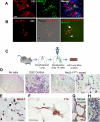Efficient derivation of purified lung and thyroid progenitors from embryonic stem cells
- PMID: 22482505
- PMCID: PMC3322392
- DOI: 10.1016/j.stem.2012.01.019
Efficient derivation of purified lung and thyroid progenitors from embryonic stem cells
Abstract
Two populations of Nkx2-1(+) progenitors in the developing foregut endoderm give rise to the entire postnatal lung and thyroid epithelium, but little is known about these cells because they are difficult to isolate in a pure form. We demonstrate here the purification and directed differentiation of primordial lung and thyroid progenitors derived from mouse embryonic stem cells (ESCs). Inhibition of TGFβ and BMP signaling, followed by combinatorial stimulation of BMP and FGF signaling, can specify these cells efficiently from definitive endodermal precursors. When derived using Nkx2-1(GFP) knockin reporter ESCs, these progenitors can be purified for expansion in culture and have a transcriptome that overlaps with developing lung epithelium. Upon induction, they can express a broad repertoire of markers indicative of lung and thyroid lineages and can recellularize a 3D lung tissue scaffold. Thus, we have derived a pure population of progenitors able to recapitulate the developmental milestones of lung/thyroid development.
Copyright © 2012 Elsevier Inc. All rights reserved.
Figures







References
-
- Ali NN, Edgar AJ, Samadikuchaksaraei A, Timson CM, Romanska HM, Polak JM, Bishop AE. Derivation of type II alveolar epithelial cells from murine embryonic stem cells. Tissue Eng. 2002;8:541–550. - PubMed
-
- Ameri J, Ståhlberg A, Pedersen J, Johansson JK, Johannesson MM, Artner I, Semb H. FGF2 specifies hESC-derived definitive endoderm into foregut/midgut cell lineages in a concentration-dependent manner. Stem Cells. 2010;28:45–56. - PubMed
Publication types
MeSH terms
Substances
Associated data
- Actions
Grants and funding
- 1R01 HL108678/HL/NHLBI NIH HHS/United States
- 1RC2HL101535-01/HL/NHLBI NIH HHS/United States
- R01 HL108678/HL/NHLBI NIH HHS/United States
- T32 HL007035/HL/NHLBI NIH HHS/United States
- P01HL047049-16A1/HL/NHLBI NIH HHS/United States
- P01 HL047049/HL/NHLBI NIH HHS/United States
- 1R01 HL095993-01/HL/NHLBI NIH HHS/United States
- R01 HL111574/HL/NHLBI NIH HHS/United States
- R21 HL109786/HL/NHLBI NIH HHS/United States
- R21 HL108055/HL/NHLBI NIH HHS/United States
- R01 HL095993/HL/NHLBI NIH HHS/United States
- RC2 HL101535/HL/NHLBI NIH HHS/United States
LinkOut - more resources
Full Text Sources
Other Literature Sources
Molecular Biology Databases
Research Materials

